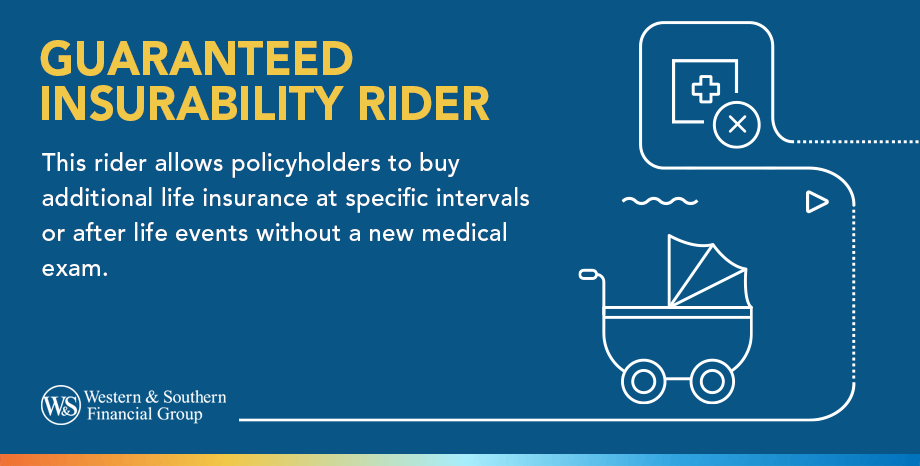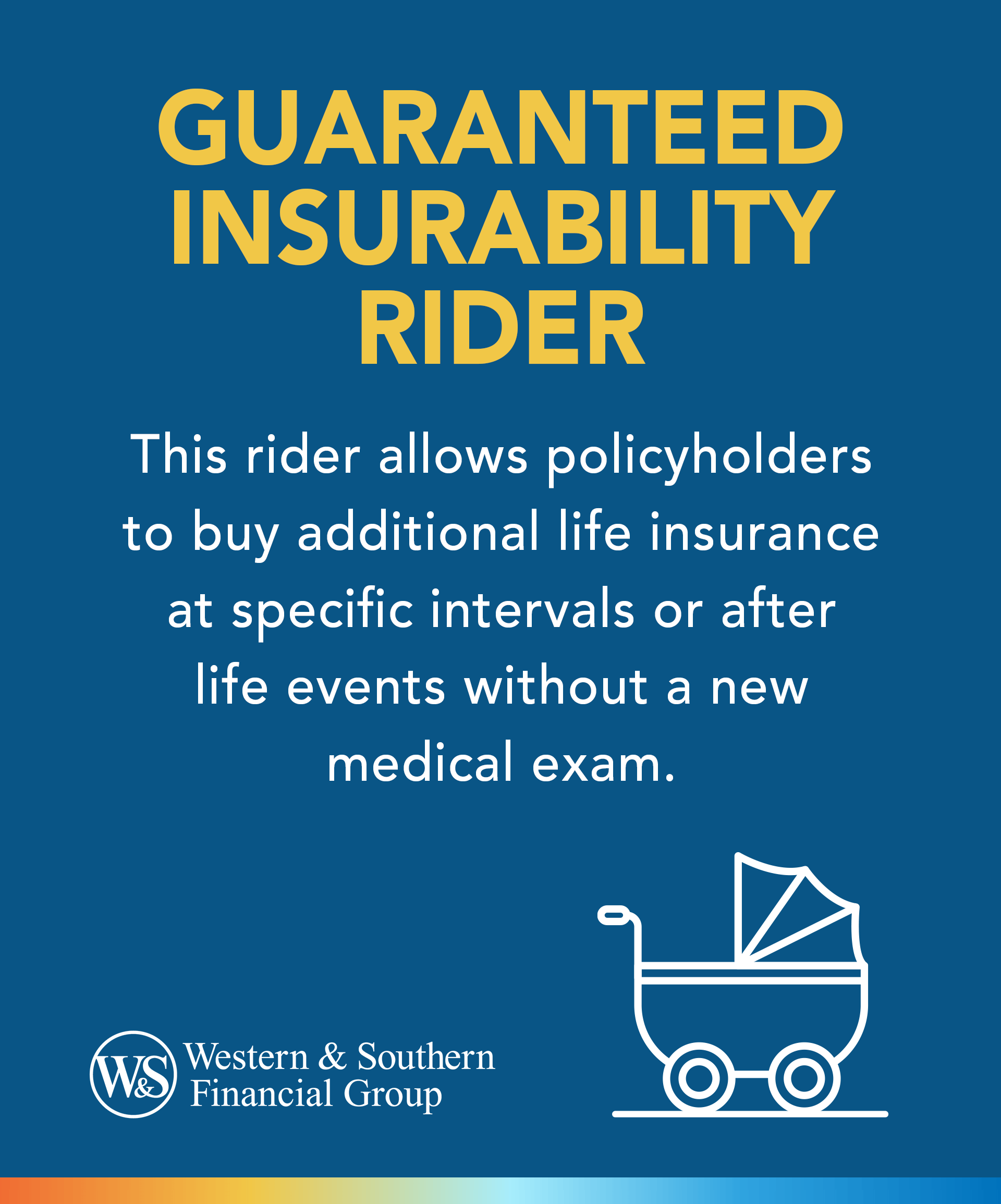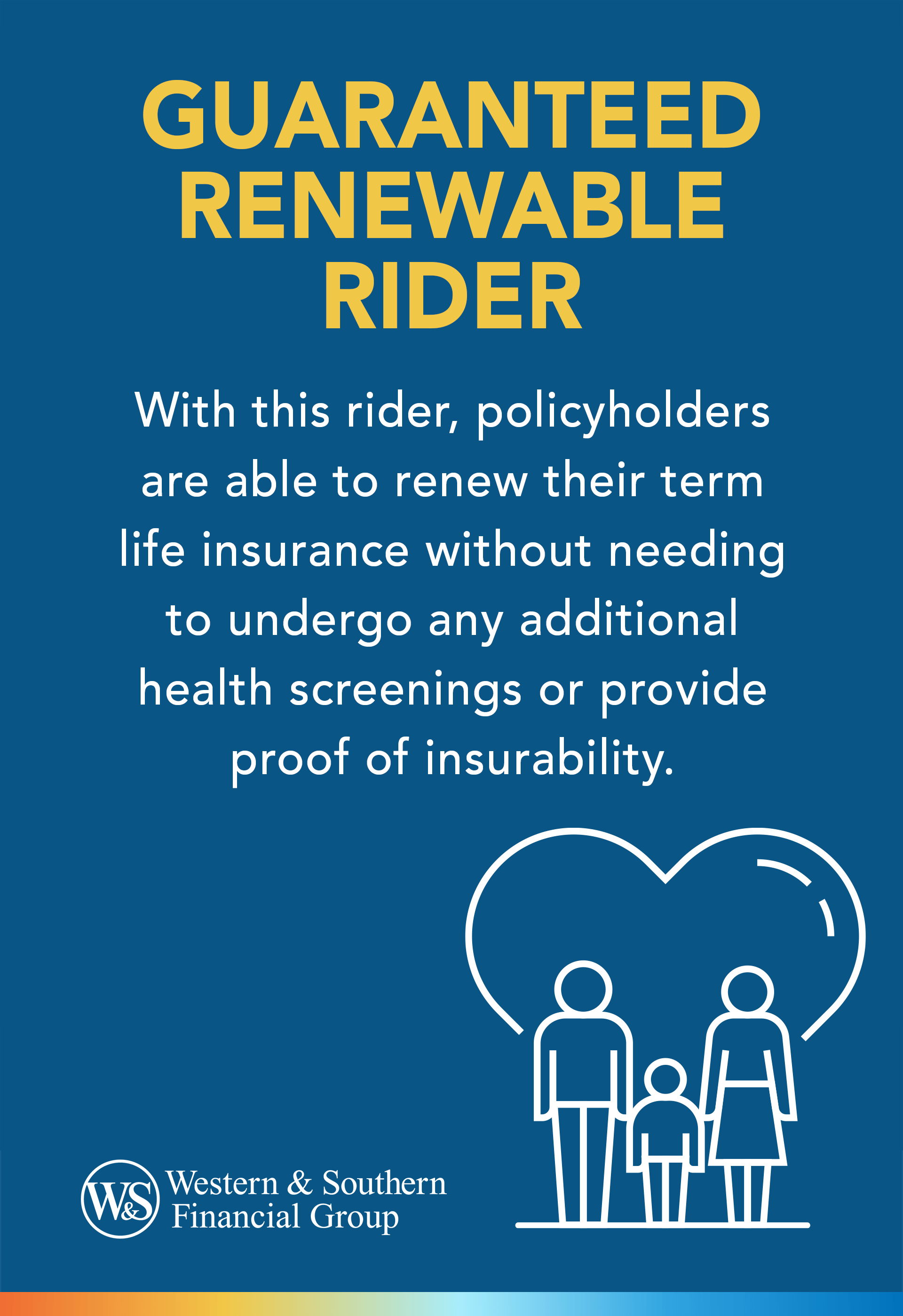Table of Contents



Key Takeaways
- Guaranteed Insurability Rider: An additional benefit that allows increasing coverage without a medical exam or being denied due to health conditions.
- Impact on Premiums: Adding coverage through the rider increases premiums based on age, not health.
- Health Rating and Qualification: The same health rating is used for the extra coverage, regardless of new health issues.
- Benefits: Flexibility to increase coverage in the future, protection against future health issues, and regular insurance review reminders.
- Considerations: Suitable for whole life policies, limited use for term life insurance, and may not be necessary if sufficient coverage is already in place.
What Is a Guaranteed Insurability Rider?
A guaranteed insurability rider (sometimes known as a guaranteed purchase option) is an add-on provision to a life insurance policy that provides the policyholder the right to purchase additional life insurance coverage at specified future dates without undergoing a new medical exam or providing evidence of insurability.
A guaranteed insurability rider can be added to permanent life insurance policies such as whole life insurance or universal life insurance. Depending upon the life insurance company, it may also be added to guaranteed issue life insurance or a term life insurance policy.
A clear understanding of what a guaranteed insurability rider can significantly affect individuals looking for complete coverage with their life insurance policies. This rider is an example of a life insurance living benefit.
How Often Can You Use a Guaranteed Insurability Rider?
The frequency with which you can exercise the options provided by a guaranteed insurability rider (GIR) depends on the terms specified in the rider. Here's a general overview:
- Time-Based Opportunities: Many GIRs offer the chance to increase coverage at regular intervals. For example, every three years or at specific ages, such as 25, 30, 35, etc.
- Life Event Triggers: Some GIRs allow you to exercise the option after specific life events, including marriage, birth or adoption of a child, or purchasing a home.
- Combination: Some policies might offer both time-based opportunities and life event triggers.
The specifics of how often you can use a guaranteed insurability rider and under what circumstances will be outlined in the rider's terms and conditions. If you're considering adding a GIR to your policy, or if you already have one, it's essential to thoroughly read and understand these terms or consult with an insurance professional to clarify any uncertainties.
How Does a Guaranteed Insurability Rider Work?
Here's how the guaranteed insurability rider typically works:
Initial Policy Purchase: When buying a life insurance policy, you can add the guaranteed insurability rider for an additional premium.
Predetermined Intervals or Life Events: The rider specifies certain times or events when you can increase your coverage. These life milestones can be:
- Time-based: For example, every three or five years.
- Event-based: Such as after getting married, the birth of a child, or buying a home.
Exercising the Option: When one of these predetermined intervals or certain life events occurs, you can purchase additional coverage. You can decide whether or not you want to increase your coverage at that time without a medical exam.
No Medical Exam: If you choose to buy additional coverage during these intervals or after these events, you won't be required to undergo a medical exam or answer health-related questions.
Premium Increase: While you won't be rated to pay higher premiums based on health changes, the premium for the increased coverage will be based on your age at the time of the increase. This means you'll pay more for the additional insurance not because of new health issues or status changes but because you're older.
Maximum Limit: The rider will have a cap on how much additional coverage you can purchase. This limit might be a set dollar amount or a percentage of the original policy's face value.
Age Restrictions: There's often an age limit by which you can exercise these options. For instance, the rider might allow guaranteed insurability until the policyholder reaches the age of 50 or 60.
Decision Window: Typically, there's a limited window after a qualifying event or interval in which you must decide whether to purchase the additional coverage. If you miss this window, you must wait until the next opportunity.
It's important to note that the specifics of a life insurance policy's death benefit and life insurance riders can vary depending on the insurance company and the specific policy terms and conditions. Always review the policy's details and consult with an insurance professional to fully understand life insurance options' benefits, limitations, and costs.
Who Is Eligible for a Guaranteed Insurability Rider?
Eligibility for a guaranteed insurability rider (GIR) can vary based on the insurance company and the specifics of the policy, but here are some general guidelines:
Age Limits: The rider is typically available to policyholders within a specific age range when they first purchase the policy. This age range is often between the late teens to early 40s, but the specifics can vary by insurer.
Policy Type: The GIR is typically available for permanent life insurance policies like whole life or universal life insurance. It may also be available for term life insurance policies, but this can vary by insurer.
Initial Health Status: While the rider allows you to purchase additional coverage in the future without proving insurability, your initial health status at the time of the original policy purchase can still affect eligibility. If you have severe enough health conditions or issues when first applying for the policy, the insurance company might not offer the GIR or could place certain restrictions on it.
No Existing GIR: If you already have a life insurance policy with a GIR, some insurance companies might not allow you to purchase another life insurance policy with the same GI rider. This is to prevent over-insurance.
Policy Size: Some insurers might only offer the GIR for policies with a minimum or maximum death benefit.
Determine if guaranteed insurability aligns with your personal insurance goals. Get a Life Insurance Quote
What Are the Benefits of a Guaranteed Insurability Rider?
A guaranteed insurability rider (GIR) offers several advantages to policyholders. Here are the primary benefits:
- Protection Against Future Uninsurability: One of the most significant benefits is the guarantee that you can purchase additional coverage without proving your insurability.
- No Medical Exams: If you exercise the GIR option and purchase additional coverage, you won't need to undergo a new medical exam or provide recent health records.
- Flexibility: As life changes—like getting married, having children, buying a house, or starting a business—you might need more insurance coverage. The GIR offers the flexibility to adjust your coverage in line with these evolving needs.
- Peace of Mind: Knowing that you can obtain more coverage in the future, irrespective of any health changes, can help bring peace of mind, especially for individuals with family histories of health problems or those working in professions with more significant health risks.
- Financial Strategy: For those using life insurance as a part of their financial planning or estate planning strategy, the GIR ensures that they can adjust their coverage to match their financial goals and legacy aspirations, regardless of health changes.
While there are undeniable benefits to having a guaranteed insurability rider, it's essential to evaluate one's personal health risk, family history, financial situation, and insurance coverage before deciding to add such a rider. It's also vital to thoroughly understand the rider's terms, conditions, and exclusions.
What Are the Potential Drawbacks of the Guaranteed Insurability Rider?
While the guaranteed insurability rider (GIR) offers many benefits, it's essential also to consider its potential drawbacks:
- Additional Cost: Including a GIR on your policy usually comes with an additional premium. While the rider provides valuable options, not every policyholder will use the benefit.
- Limited Increase Amount: The GIR often has a cap on how much additional coverage you can purchase at each opportunity.
- Potential for Over-insurance: Some individuals may be prompted to buy more insurance than they need, thinking they should maximize the rider's benefit.
- Missed Exercise Windows: The rider usually provides specific intervals or life events when you can increase your coverage. If you miss these windows, you might not get another chance until the next predefined opportunity.
- Not Always Necessary: The GIR might be an unnecessary addition for individuals with stable insurance need that aren't anticipated to increase.
When considering a guaranteed insurability rider, it's essential to carefully evaluate its potential drawbacks and benefits to determine if it aligns with your insurance needs.
How Much Does a Guaranteed Insurability Rider Cost?
The cost of purchasing additional coverage through a guaranteed insurability rider (GIR) can differ between insurance providers and is affected by various factors. Here's a breakdown of the considerations that may affect its cost:
The insurer: Insurance companies price their products differently based on their underwriting guidelines and risk assessment models.
The policyholder: Age, other health issues, lifestyle, occupation, and whether or not you smoke can all affect the cost of a life insurance premium, and this carries over into the cost of a GIR as well.
The policy: The cost of a GIR is often a percentage of the base policy premium resulting in policies with higher premiums potentially having a higher cost for the GIR. Additional factors impacting cost can include the type of policy, the rider features, and the extra coverage amount.
Even though the guaranteed insurability rider is a valuable add-on, it is important to balance the benefits and the extra expenses that come with it.
Is the Guaranteed Insurability Rider Right for You?
Whether a guaranteed insurability rider (GIR) is worth it depends on your circumstances, financial goals, and risk tolerance. While it may benefit specific individuals, the added expense may not be worth it for everyone. Here are some factors to consider when deciding if it is suitable for you:
Cost vs. Benefit Analysis: Weigh the additional premium against the potential future cost of more life insurance, if you had to undergo underwriting later in life, especially if your health has deteriorated.
Future Predictability: If your life is relatively predictable and you don't foresee significant changes in your insurance needs, the GIR might not offer as much value.
As with all financial decisions, discussing your options with a financial advisor or insurance professional is recommended. They can help you evaluate the costs and benefits of financial protection based on your specific needs and goals.
Remember that various types of life insurance policies and optional life insurance riders may suit your needs and financial situation. It is important to take the time to thoroughly research buying life insurance and consider all available options, taking into account your financial objectives, family, and personal preferences.
Include guaranteed insurability to flexibly adapt your insurance over time. Get a Life Insurance Quote














